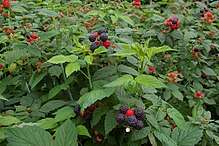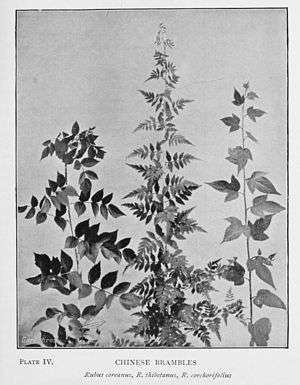Rubus coreanus
Rubus coreanus, known as bokbunja,[3] Korean blackberry,[3] or Korean bramble,[4] is a species of raspberry native to Korea, Japan, and China.[5] It produces edible berries (not true berries in the botanical sense) that are fermented into bokbunja ju, a Korean fruit wine (although the majority of fruit commercially grown for producing this drink are actually Rubus occidentalis, native to North America).[6][7][8][9]
| Rubus coreanus | |
|---|---|
 | |
| Scientific classification | |
| Kingdom: | Plantae |
| Clade: | Tracheophytes |
| Clade: | Angiosperms |
| Clade: | Eudicots |
| Clade: | Rosids |
| Order: | Rosales |
| Family: | Rosaceae |
| Genus: | Rubus |
| Species: | R. coreanus |
| Binomial name | |
| Rubus coreanus Miq. 1867 | |
| Synonyms[1] | |
| |

The wine made of bokbunja is called bokbunjaju (Korean: 복분자주).
See also
References
- "The Plant List: A Working List of All Plant Species".
- photo from Watson, William, Climbing plants Publisher: London [etc.] : T.C. & E.C. Jack Language
- English Names for Korean Native Plants (PDF). Pocheon: Korea National Arboretum. 2015. p. 336. ISBN 978-89-97450-98-5. Archived from the original (PDF) on 25 May 2017. Retrieved 22 December 2016 – via Korea Forest Service.
- "BSBI List 2007". Botanical Society of Britain and Ireland. Archived from the original (xls) on 2015-01-25. Retrieved 2014-10-17.
- "Rubus coreanus Miquel". Flora of China.
- "Phylogenetic relationships of Rubus species revealed by randomly amplified polymorphic DNA markers" (PDF). Eu et al. 2008. J. Crop Sci. Biotech. 11(1):39-44. Archived from the original (PDF) on 2012-03-13.
- "Mistaken identity: clarification of Rubus coreanus Miquel (bokbunja)". Lee et al. 2014. Molecules. 91(7):10524–10533. Archived from the original on 2015-04-15.
- Lee, Jungmin; Dossett, Michael; Finn, Chad E. (2013). "Anthocyanin fingerprinting of true bokbunja (Rubus coreanus Miq.)". Journal of Functional Foods, Lee et Al. 2013. J. Funct. Foods 5(4):1985-1990. 5 (4): 1985–1990. doi:10.1016/j.jff.2013.06.006.
- Lee, Jungmin (2015). "Analysis of bokbunja products show they contain Rubus occidentalis L. fruit". Lee 2015. J. Funct. Foods 12:144-149. 12: 144–149. doi:10.1016/j.jff.2014.11.005.
This article is issued from Wikipedia. The text is licensed under Creative Commons - Attribution - Sharealike. Additional terms may apply for the media files.